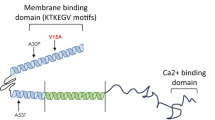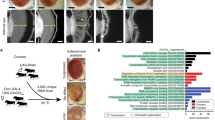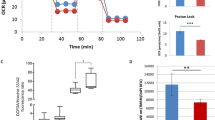Abstract
Polyglutamine (polyQ) diseases are a class of dominantly inherited neurodegenerative disorders caused by the expansion of a CAG repeat encoding glutamine within the coding region of the respective genes1. The molecular and cellular pathways underlying polyQ-induced neurodegeneration are the focus of much research, and it is widely considered that toxic activities of the protein, resulting from the abnormally long polyQ tract, cause pathogenesis2,3. Here we provide evidence for a pathogenic role of the CAG repeat RNA in polyQ toxicity using Drosophila. In a Drosophila screen for modifiers of polyQ degeneration induced by the spinocerebellar ataxia type 3 (SCA3) protein ataxin-3, we isolated an upregulation allele of muscleblind (mbl), a gene implicated in the RNA toxicity of CUG expansion diseases4,5,6. Further analysis indicated that there may be a toxic role of the RNA in polyQ-induced degeneration. We tested the role of the RNA by altering the CAG repeat sequence to an interrupted CAACAG repeat within the polyQ-encoding region; this dramatically mitigated toxicity. In addition, expression of an untranslated CAG repeat of pathogenic length conferred neuronal degeneration. These studies reveal a role for the RNA in polyQ toxicity, highlighting common components in RNA-based and polyQ-protein-based trinucleotide repeat expansion diseases.
This is a preview of subscription content, access via your institution
Access options
Subscribe to this journal
Receive 51 print issues and online access
$199.00 per year
only $3.90 per issue
Buy this article
- Purchase on Springer Link
- Instant access to full article PDF
Prices may be subject to local taxes which are calculated during checkout



Similar content being viewed by others
References
Orr, H. T. & Zoghbi, H. Y. Trinucleotide repeat disorders. Annu. Rev. Neurosci. 30, 575–621 (2007)
Gatchel, J. R. & Zoghbi, H. Y. Diseases of unstable repeat expansion: mechanisms and common principles. Nature Rev. Genet. 6, 743–755 (2005)
Ross, C. A. & Poirier, M. A. What is the role of protein aggregation in neurodegeneration? Nature Rev. Mol. Cell Biol. 6, 891–898 (2005)
Jiang, H., Mankodi, A., Swanson, M. S., Moxley, R. T. & Thornton, C. A. Myotonic dystrophy type 1 is associated with nuclear foci of mutant RNA, sequestration of muscleblind proteins and deregulated alternative splicing in neurons. Hum. Mol. Genet. 13, 3079–3088 (2004)
Mankodi, A. et al. Muscleblind localizes to nuclear foci of aberrant RNA in myotonic dystrophy types 1 and 2. Hum. Mol. Genet. 10, 2165–2170 (2001)
Miller, J. W. et al. Recruitment of human muscleblind proteins to (CUG)(n) expansions associated with myotonic dystrophy. EMBO J. 19, 4439–4448 (2000)
Warrick, J. M. et al. Expanded polyglutamine protein forms nuclear inclusions and causes neural degeneration in Drosophila. Cell 93, 939–949 (1998)
Begemann, G. et al. muscleblind, a gene required for photoreceptor differentiation in Drosophila, encodes novel nuclear Cys3His-type zinc-finger-containing proteins. Development 124, 4321–4331 (1997)
Artero, R. et al. The muscleblind gene participates in the organization of Z-bands and epidermal attachments of Drosophila muscles and is regulated by Dmef2. Dev. Biol. 195, 131–143 (1998)
Kanadia, R. N. et al. Reversal of RNA missplicing and myotonia after muscleblind overexpression in a mouse poly(CUG) model for myotonic dystrophy. Proc. Natl Acad. Sci. USA 103, 11748–11753 (2006)
Kino, Y. et al. Muscleblind protein, MBNL1/EXP, binds specifically to CHHG repeats. Hum. Mol. Genet. 13, 495–507 (2004)
Ho, T. H. et al. Colocalization of muscleblind with RNA foci is separable from mis-regulation of alternative splicing in myotonic dystrophy. J. Cell Sci. 118, 2923–2933 (2005)
Ranum, L. P. & Cooper, T. A. RNA-mediated neuromuscular disorders. Annu. Rev. Neurosci. 29, 259–277 (2006)
Wheeler, T. M. & Thornton, C. A. Myotonic dystrophy: RNA-mediated muscle disease. Curr. Opin. Neurol. 20, 572–576 (2007)
Philips, A. V., Timchenko, L. T. & Cooper, T. A. Disruption of splicing regulated by a CUG-binding protein in myotonic dystrophy. Science 280, 737–741 (1998)
McLeod, C. J., O’Keefe, L. V. & Richards, R. I. The pathogenic agent in Drosophila models of ‘polyglutamine’ diseases. Hum. Mol. Genet. 14, 1041–1048 (2005)
Marsh, J. L. et al. Expanded polyglutamine peptides alone are intrinsically cytotoxic and cause neurodegeneration in Drosophila. Hum. Mol. Genet. 9, 13–25 (2000)
Emamian, E. S. et al. Serine 776 of ataxin-1 is critical for polyglutamine-induced disease in SCA1 transgenic mice. Neuron 38, 375–387 (2003)
Graham, R. K. et al. Cleavage at the caspase-6 site is required for neuronal dysfunction and degeneration due to mutant huntingtin. Cell 125, 1179–1191 (2006)
Klement, I. A. et al. Ataxin-1 nuclear localization and aggregation: role in polyglutamine-induced disease in SCA1 transgenic mice. Cell 95, 41–53 (1998)
Goti, D. et al. A mutant ataxin-3 putative-cleavage fragment in brains of Machado-Joseph disease patients and transgenic mice is cytotoxic above a critical concentration. J. Neurosci. 24, 10266–10279 (2004)
Warrick, J. M. et al. Ataxin-3 suppresses polyglutamine neurodegeneration in Drosophila by a ubiquitin-associated mechanism. Mol. Cell 18, 37–48 (2005)
Jin, P. et al. RNA-mediated neurodegeneration caused by the fragile X premutation rCGG repeats in Drosophila. Neuron 39, 739–747 (2003)
Ranum, L. P. & Day, J. W. Pathogenic RNA repeats: an expanding role in genetic disease. Trends Genet. 20, 506–512 (2004)
Tapscott, S. J. & Thornton, C. A. Reconstructing myotonic dystrophy. Science 293, 816–817 (2001)
Cho, D. H. et al. Antisense transcription and heterochromatin at the DM1 CTG repeats are constrained by CTCF. Mol. Cell 20, 483–489 (2005)
Moseley, M. L. et al. Bidirectional expression of CUG and CAG expansion transcripts and intranuclear polyglutamine inclusions in spinocerebellar ataxia type 8. Nature Genet. 38, 758–769 (2006)
Osherovich, L. Z. & Weissman, J. S. Multiple Gln/Asn-rich prion domains confer susceptibility to induction of the yeast [PSI(+)] prion. Cell 106, 183–194 (2001)
Garcia-Casado, M. Z., Artero, R. D., Paricio, N., Terol, J. & Perez-Alonso, M. Generation of GAL4-responsive muscleblind constructs. Genesis 34, 111–114 (2002)
Jung, J. & Bonini, N. CREB-binding protein modulates repeat instability in a Drosophila model for polyQ disease. Science 315, 1857–1859 (2007)
Acknowledgements
We thank A. Cashmore, D. Lessing and R. Pittman for comments, J. Weissman, C. Thornton, M. Baylies, R. Artero and the Developmental Studies Hybridoma Bank (supported by the National Institute of Child Health and Human Development and the University of Iowa) for reagents. These studies were supported by the National Institute of Neurological Disorders and Stroke (to N.M.B.). N.M.B. is an Investigator of the Howard Hughes Medical Institute.
Author information
Authors and Affiliations
Corresponding author
Supplementary information
Supplementary information
The file contains Supplementary Tables S1-S2, Supplementary Figures S1-S16 with Legends and additional references. (PDF 1054 kb)
Rights and permissions
About this article
Cite this article
Li, LB., Yu, Z., Teng, X. et al. RNA toxicity is a component of ataxin-3 degeneration in Drosophila. Nature 453, 1107–1111 (2008). https://doi.org/10.1038/nature06909
Received:
Accepted:
Published:
Issue Date:
DOI: https://doi.org/10.1038/nature06909
This article is cited by
-
m1A in CAG repeat RNA binds to TDP-43 and induces neurodegeneration
Nature (2023)
-
Consensus Paper: Strengths and Weaknesses of Animal Models of Spinocerebellar Ataxias and Their Clinical Implications
The Cerebellum (2022)
-
A Novel SCA3 Knock-in Mouse Model Mimics the Human SCA3 Disease Phenotype Including Neuropathological, Behavioral, and Transcriptional Abnormalities Especially in Oligodendrocytes
Molecular Neurobiology (2022)
-
Molecular mechanisms underlying nucleotide repeat expansion disorders
Nature Reviews Molecular Cell Biology (2021)
-
Huntington’s disease brain-derived small RNAs recapitulate associated neuropathology in mice
Acta Neuropathologica (2021)
Comments
By submitting a comment you agree to abide by our Terms and Community Guidelines. If you find something abusive or that does not comply with our terms or guidelines please flag it as inappropriate.



